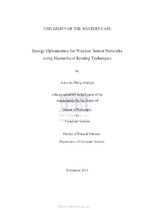| dc.description.abstract | Wireless sensor networks (WSNs) have become a popular research area that is widely
gaining the attraction from both the research and the practitioner communities due to their
wide area of applications. These applications include real-time sensing for audio delivery,
imaging, video streaming, and remote monitoring with positive impact in many fields such
as precision agriculture, ubiquitous healthcare, environment protection, smart cities and
many other fields. While WSNs are aimed to constantly handle more intricate functions
such as intelligent computation, automatic transmissions, and in-network processing, such
capabilities are constrained by their limited processing capability and memory footprint as
well as the need for the sensor batteries to be cautiously consumed in order to extend their
lifetime. This thesis revisits the issue of the energy efficiency in sensor networks by
proposing a novel clustering approach for routing the sensor readings in wireless sensor
networks. The main contribution of this dissertation is to 1) propose corrective measures to
the traditional energy model adopted in current sensor networks simulations that
erroneously discount both the role played by each node, the sensor node capability and
fabric and 2) apply these measures to a novel hierarchical routing architecture aiming at
maximizing sensor networks lifetime. We propose three energy models for sensor network:
a) a service-aware model that account for the specific role played by each node in a sensor
network b) a sensor-aware model and c) load-balancing energy model that accounts for the sensor node fabric and its energy footprint. These two models are complemented by a load balancing
model structured to balance energy consumption on the network of cluster heads
that forms the backbone for any cluster-based hierarchical sensor network. We present two
novel approaches for clustering the nodes of a hierarchical sensor network: a) a distanceaware
clustering where nodes are clustered based on their distance and the residual energy
and b) a service-aware clustering where the nodes of a sensor network are clustered
according to their service offered to the network and their residual energy. These
approaches are implemented into a family of routing protocols referred to as EOCIT
(Energy Optimization using Clustering Techniques) which combines sensor node energy
location and service awareness to achieve good network performance. Finally, building
upon the Ant Colony Optimization System (ACS), Multipath Routing protocol based on
Ant Colony Optimization approach for Wireless Sensor Networks (MRACO) is proposed
as a novel multipath routing protocol that finds energy efficient routing paths for sensor
readings dissemination from the cluster heads to the sink/base station of a hierarchical
sensor network. Our simulation results reveal the relative efficiency of the newly proposed
approaches compared to selected related routing protocols in terms of sensor network
lifetime maximization. | en_US |

